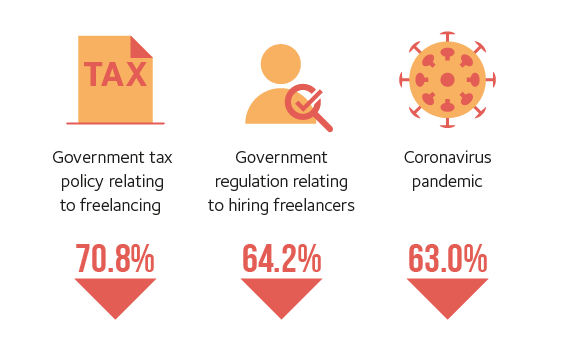- Home
- Knowledge
- Resource library
- Freelancer Confidence Index Q3 2021
Freelancer Confidence Index Q3 2021
- Research
- 30 Nov 2021
- Joshua Toovey
- Freelancers state that the main factor negatively affecting their business this quarter is government tax policy – above the pandemic, inflation and Brexit.
- Freelancers’ confidence in the UK economy has significantly decreased compared to last quarter – falling from 22.8 in Q2 2021 to -13.2 this quarter.
- Freelancers’ average quarterly earnings have seen a large increase, with average earnings standing at £24,606 this quarter – the highest reported figure since Q4 2018.
- This was driven by rising day rates (up from £397 to £537) and falling spare capacity (down from 3.7 to 3.1 weeks).
While the country continues to recover post lockdown, freelancers’ confidence in the UK economy has fallen dramatically - from 22.8 in Q2 2021 to -13.2 in Q3 2021.

Looking at the different freelancer groups, confidence remains bleak. Whilst SOC1 managerial freelancers saw the biggest increase from Q1 to Q2 2021 (from -15.8 to 43.5), they also experienced the largest decrease from Q2 2021 to this quarter, falling from 43.5 to -14.7. SOC2 professional freelancers and SOC3 associate professional and technical freelancers also saw a significant decrease compared to last quarter, falling from 21.1 to -17.1 and 11.5 to -8.7 respectfully.
The dramatic fall in confidence in Q3 can be attributed to the government’s IR35 tax legislation, which has severely damaged an already scarred contracting sector. This is reflected in the fact that the vast majority (70.8%) of freelancers have stated that the main factor negatively affecting their businesses this quarter was government tax policy - followed by government regulation (64.2%) and the pandemic (63.0%).

However, while confidence slumps, signs of positivity can be found in changes to freelancers’ day rates in Q3 2021. Day rates have markedly increased across the board, with the average day rate charged by freelancers over the past three months now standing at £537. This represents the highest average day rate since the establishment of the Confidence Index in 2014, although some of this can be attributed to freelancers charging a higher ‘inside IR35’ rate to mitigate the associated costs, such as covering the liability of Employer's National Insurance and, where applicable, the Apprenticeship Levy. Moreover, over half (51%) of freelancers predict that day rates will continue to rise over the next 12 months.
Encouragingly, the rise in day rates is coupled with a decrease in the number of weeks without work, down from 3.7 weeks in Q2 2021 to 3.1 weeks this quarter and representing the lowest average since prior to the pandemic in Q4 2019.
With a combination of increased day rates and increased freelancer capacity utilisation, freelancers’ average quarterly earnings have also seen a large increase, with average earnings standing at £24,606 this quarter – the highest reported figure since Q4 2018 and driven by increases across all three SOC groups.
Read the full report here
Meet the author

Joshua Toovey
Senior Research and Policy Officer
